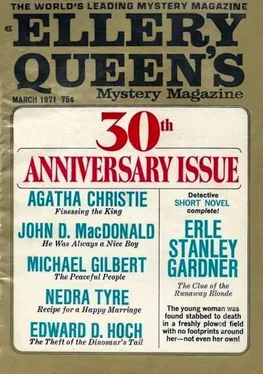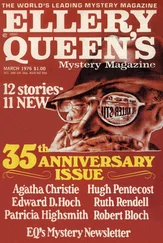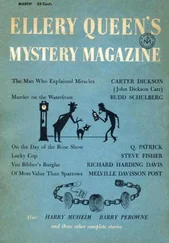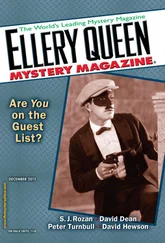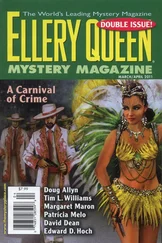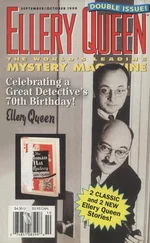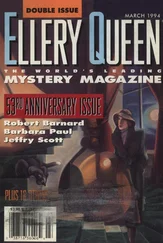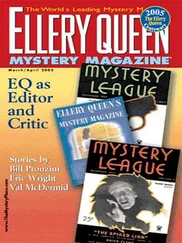Jon Breen - Ellery Queen’s Mystery Magazine, Vol. 57, No. 3. Whole No. 328, March 1971
Здесь есть возможность читать онлайн «Jon Breen - Ellery Queen’s Mystery Magazine, Vol. 57, No. 3. Whole No. 328, March 1971» весь текст электронной книги совершенно бесплатно (целиком полную версию без сокращений). В некоторых случаях можно слушать аудио, скачать через торрент в формате fb2 и присутствует краткое содержание. Город: New York, Год выпуска: 1971, Издательство: Davis Publications, Жанр: Классический детектив, на английском языке. Описание произведения, (предисловие) а так же отзывы посетителей доступны на портале библиотеки ЛибКат.
- Название:Ellery Queen’s Mystery Magazine, Vol. 57, No. 3. Whole No. 328, March 1971
- Автор:
- Издательство:Davis Publications
- Жанр:
- Год:1971
- Город:New York
- ISBN:нет данных
- Рейтинг книги:3 / 5. Голосов: 1
-
Избранное:Добавить в избранное
- Отзывы:
-
Ваша оценка:
- 60
- 1
- 2
- 3
- 4
- 5
Ellery Queen’s Mystery Magazine, Vol. 57, No. 3. Whole No. 328, March 1971: краткое содержание, описание и аннотация
Предлагаем к чтению аннотацию, описание, краткое содержание или предисловие (зависит от того, что написал сам автор книги «Ellery Queen’s Mystery Magazine, Vol. 57, No. 3. Whole No. 328, March 1971»). Если вы не нашли необходимую информацию о книге — напишите в комментариях, мы постараемся отыскать её.
Ellery Queen’s Mystery Magazine, Vol. 57, No. 3. Whole No. 328, March 1971 — читать онлайн бесплатно полную книгу (весь текст) целиком
Ниже представлен текст книги, разбитый по страницам. Система сохранения места последней прочитанной страницы, позволяет с удобством читать онлайн бесплатно книгу «Ellery Queen’s Mystery Magazine, Vol. 57, No. 3. Whole No. 328, March 1971», без необходимости каждый раз заново искать на чём Вы остановились. Поставьте закладку, и сможете в любой момент перейти на страницу, на которой закончили чтение.
Интервал:
Закладка:
“No,” he agreed. “I don’t think they are.”
On Monday morning Nick drove down to New York. He left the Major Deegan Expressway at 155th Street and crossed the Harlem River into Manhattan’s northern limits. From there it was only a five-minute drive to the Museum of Ancient History, a big rambling redbrick monstrosity that reminded him of the Smithsonian on a bad day. The parking lot was nearly deserted this early, and he pulled up near the front entrance.
Inside, the place was all that its exterior promised — high ceilings with dusty skylights, marble floors, an air of mustiness that seemed to filter right through his clothes. It was everything a museum of the 1920’s should have been, and if it was still that way nearly a half century later, one could only sigh with regret and remember those earlier, grander days.
Nick made his way through the Egyptian Room and the Etruscan Wing, coming at last to the Hall of Great Reptiles. And there it was, in all its baroque splendor — Tyrannosaurus Rex, towering 25 feet into the air and stretching back nearly 50 feet from head to tail. There was something sad and oddly dated about the hundreds of polished bones wired together as a memorial to this creature of long ago. After the indignities of the zoo, would modern animals be subjected to such extravagancies, too? He’d read somewhere that only 600 tigers remained in the world, and he wondered if some future generation might be forced to view the skeleton of a charging Bengal as he now-viewed this blanched relic.
He walked the full length of the great beast and paused to examine the jointed tail section. There was certainly nothing remarkable about the dozens of small bones that made up the tail. He bent closer across the rope barrier for a better look, but there was nothing to explain his assignment. He’d hardly expected a jeweled tail, for example; yet there must be some reason for the proposed theft.
Almost at once a uniformed guard appeared and called out, “Not too close there, mister. Them things are delicate!”
“Sorry. Just wanted a good look. Know where these bones came from?”
The guard moved closer, friendly now. “Out west somewhere. It tells on the sign. In most of these skeletons we have to use some fake bones. It’s impossible to find one of these things complete.”
Nick nodded and turned away, not wanting to show too much interest. “It sure was big,” he said by way of conclusion, and drifted back to the Etruscan Wing.
He might have passed directly through to the Egyptian Room if he hadn’t recognized a familiar face bent over one of the glass display cases. It was that of Lynn Peters, the girl he’d met at Kincaid’s house. Her flushed cheeks and sandy hair were unmistakable, even if she was not wearing her riding costume.
“Hello there,” he said. “I believe we met yesterday after the horse trials.”
She turned, the fresh young smile coming naturally to her face. “Oh, it’s Mr. Velvet, isn’t it? I had a nice chat with your wife last evening.”
“Gloria’s just a friend,” he corrected her amiably. “But what brings you here? I don’t see a single horse in the whole place. Not a live one, anyway.”
“They’re having a special exhibit of antique jewelry, including some pieces from ancient Egypt.” She led him to a nearby case filled with what looked to him like beaded trinkets. “That necklace of gold and jasper and amethyst is from the twelfth dynasty — two thousand years B.C.! Can you imagine?”
She seemed genuinely excited by the necklace, and Nick had to pretend a mild interest. Almost at once he noticed another guard, watching them from a high balcony that ran around the room. “This place is alive with guards, isn’t it? Don’t they trust anyone?”
Lynn Peters brushed the long hair from her eyes. “They’ve had some trouble — a number of robberies during the past couple of years. The latest one, a few months back, was the last straw, I guess. Someone stole the famous Pliny diamond, one of several brought from India to Rome about the year 60 A.D., and described by Pliny in his writings.”
Nick grunted, vaguely remembering having read something about the robbery in the papers. “I don’t know much Roman history, but I always thought Pliny was a politician of some sort.”
“Pliny the Younger was, but his father was. a naturalist. He wrote a thirty-seven-volume Natural History , which still survives. The diamond that bears his name is a really fabulous stone, almost priceless. Though of course it doesn’t have the brilliancy of modem gems.”
“Why is that?”
“The art of lapidary wasn’t fully developed until the middle years of the Eighteenth Century — around 1746, to be exact. Before that, very little was known about the faceting of diamonds to give them the sparkle and brilliance we know today.”
“You speak like a true authority.”
She smiled at the compliment. “I’m studying to be a lapidarist. I work at the diamond exchange on West Forty-seventh Street.”
“An unusual occupation for a young lady.”
The grin turned impish. “Did you think I spent my life falling off horses?”
“Hardly.” He was watching the guard on the balcony. “Just what happened to this Pliny diamond?”
“It was stolen from one of these showcases, just as other jewelry had been earlier. An alarm sounded when the glass was broken, of course, but by the time the guards got here there was no sign of the thief. Each of the thefts happened during the daytime hours, which is why they now have a guard assigned to every room. At night they have an elaborate alarm system, and two guard dogs patrol the place.” She chuckled at the thought. “I always imagine the dogs carrying off the dinosaur bones and burying them somewhere.”
“That stolen diamond would be difficult to dispose of, wouldn’t it?”
“Not if it was cut up and refaceted. Pieces of a necklace from a similar robbery turned up with a fence in Boston. Museum robberies have been quite a problem around New York ever since the Star of India was stolen from the Museum of Natural History back in 1964.”
Nick nodded. The watching guard made him nervous, and he didn’t know how far their voices might carry in this high-ceilinged room. “Look,” he decided suddenly, “I have to be going. Can I drop you anywhere?”
She shook her head. “This is part of my homework.”
“Is this Egyptian stuff valuable, too?”
Lynn shrugged. “Depends on what you mean by valuable. To a collector it would be priceless, though it’s not the sort of thing a fence would care to handle.”
He nodded and started for the door. “I’ll see you around. Don’t fall off any more horses!”
Each time Nick Velvet was handed an assignment like this he reminded himself of the Clouded Tiger affair, some years back. In that one he’d been hired to steal a tiger from a zoo and it turned out to be only a means of drawing attention from the real crime being committed at the same time. The same trick had been tried with Nick on other occasions too, but he was usually able to see through the ruse and bow out in time. He didn’t like being played for a patsy, and he had a suspicion that Frader Kincaid was trying to do just that.
No man, Nick felt, not even a dinosaur enthusiast, could have any use for the bones from a Tyrannosaurus tail. It seemed much more likely that Kincaid was connected with the museum thefts, and that he was using Nick simply to get by the added security precautions so he could enter the museum behind him and pull off another jewel robbery.
It made sense, in a way, and it might even explain why Lynn Peters had been at the museum. She t;might be working with Kincaid, watching Nick to see when he would pull the job. She might even be the lapidarist who cut up the gems for Kincaid after the robberies.
Читать дальшеИнтервал:
Закладка:
Похожие книги на «Ellery Queen’s Mystery Magazine, Vol. 57, No. 3. Whole No. 328, March 1971»
Представляем Вашему вниманию похожие книги на «Ellery Queen’s Mystery Magazine, Vol. 57, No. 3. Whole No. 328, March 1971» списком для выбора. Мы отобрали схожую по названию и смыслу литературу в надежде предоставить читателям больше вариантов отыскать новые, интересные, ещё непрочитанные произведения.
Обсуждение, отзывы о книге «Ellery Queen’s Mystery Magazine, Vol. 57, No. 3. Whole No. 328, March 1971» и просто собственные мнения читателей. Оставьте ваши комментарии, напишите, что Вы думаете о произведении, его смысле или главных героях. Укажите что конкретно понравилось, а что нет, и почему Вы так считаете.
